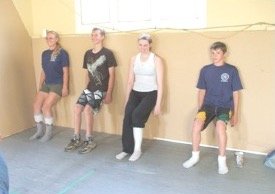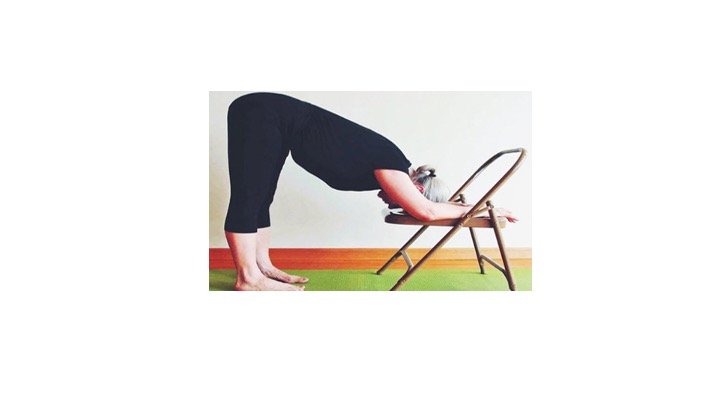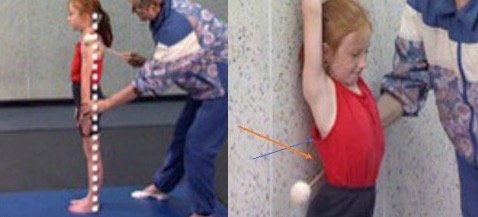Low Back Pain in Swimmers
Due to the 2-year Covid-19 pandemic, children, youth, and athletes were homebound, engaging in online learning, and becoming addicted to smartphones, social media, TV, and video games. Medical experts report an increase in bad posture, “rounded shoulder or slouch” position, and other posture-related symptoms.
Postural flaws can affect any part of the body as body parts are closely interrelated in their function, i.e., functional fitness. That means, existing low back problems can be further aggravated and/or multiplied due to lengthy sitting habits with bad posture, working routine, or other activities. In many sports, required movements of specific skills often can lead to various aches and agonies such as low back pain.
Swimming as a recreational activity is considered therapeutic in nature because it does not put pressure on joints whereas competitive swimming can bring about some serious health issues. Symptoms may start to develop in some mild form of low back pain but the athlete may not “really think anything of it” because it was not that bothersome in the weight room or in the pool. And also, other swimmers talk about their low back pain too and it does not seem to affect them.
However, low back pain can increase especially during butterfly and breaststroke training so much that the swimmer may have to limit training those strokes in practice. This is a crucial time to worry since it limits not only the training phase but also affects competitive events. Coaches and/or athletic trainers usually pre-scribe a resting period as the solution.
In my opinion, the knowledge that competitive swimming can lead to various health syndromes should motivate coaches to design and establish programs to provide a training environment for physical and mental well-being, meaning alternative action. Just performing generic and traditional exercises and stretches the athlete has done for many years in the traditional Warm-up does not produce the expected results.
Here are suggestions:
Carry out posture assessment at the Start of the Annual program, then Mid-season, and again at the End of the season
Record the results, improvements, changes and/or setbacks for each swimmer, and keep the recorded data
Based upon those results, general and specific exercises for the most known affected parts of the body (such as low back, shoulders, knees) should be incorporated, whether there is a problem or not, i.e. “preventive care not reaction” once the symptoms appear
Based on individual assessment and results, specific remedial/corrective posture exercises for body awareness and body control need to be designed and become part of daily training for each individual swimmer
These exercises need to be incorporated into the daily Pre- and/or Post-phase training*
*Note: In 2021, the Canadian Coaching Association retitled the traditional Warm-up and Cool-down as ‘Pre- and Post-training’ phases, adding general, sport-specific, and training session-specific movement competencies to every training session as they are considered to be fundamental for successful performance. Moreover, greater emphasis is now on correct posture and body control as key aspects for skill acquisition and successful performance, and to reduce the risk of injuries.
Swimmers need to carry out these exercises at home as well for set minutes (5-10 min) to improve the condition
Exercises or weight training units that increase the load on the lower back have to be voided
If coaches are not able to administer posture tests and design corrective exercises, they should consult a medical expert and/or a physiotherapist to devise overall and specific exercises
An orthopaedic specialist may be needed in severe cases
**Note: If coaches are not able to administer posture tests and/or design remedial/corrective exercises seek access to a health or medical expert or try to engage a graduate student from nearby Universities for a potential graduate Thesis or Ph.D.
Interesting News from Germany (July 13, 2022):
Julia Meyerdierks reports: “Endlich wieder Boden unter den Füßen spüren” [finally, to feel more ground beneath the feet] and the rise of FFK [Freifußkultur = Free feet culture]. She states that walking barefoot at home (if grass, sand and beaches are not available) should be done more regularly because it is healthy for the feet, joints, and the back. Too many modern-designed shoes are causing back and foot problems, which is unfortunate as feet affect the lower back! Subsequently, several shoe manufacturers have now gone to simulate the ‘barefoot feeling’ in their shoe wear with flexible soles (ultra-light wear) to provide shoes with the “feel of bare footing” along with more room for toes, under the slogan “going barefoot is like brain-jogging.”
To summarize, the concepts have enhanced the focus on lowering back pain by designing better footwear. While this may be a selling and marketing point, we do know that incorrect or unsuitable shoes or sneakers can contribute to poor posture and back aches.“Barfuß ist auch gut für den Rücken” [barefoot is also good for the back] by German Professor, Dr. Med, Thomas Wessinghage, an Orthopedic as he states that our feet are biologically constructed “without shoes and heels in mind.” Shoes tend to constrict human movement and shift the stress center of gravity in the foot arch, which then affects muscles of the foot, joints, articulations, and thereby also the back.
According to Wessinghage, walking or running barefoot utilizes natural movement, and our total organ system, and inner organs profit. The body weight is centered over the hips, feet, and knees thereby strengthening our back.
These are some interesting views by Dr. Westinghage’s, whose work in Germany is well-known with injured athletes and provides some good focal points to enhance posture and relieve back pain.
For coaches to neglect health aspects related to poor posture in their program with the excuse that “one is not educated or knowledgeable enough on the subject” is not acceptable as modern coaching ethics actually require coaches to “provide a safe training and competition environment”, according to the Canadian Coaching Association ‘Code of Ethics’– Standard of Behavior.
I firmly hold the belief that swimmers should work on overall posture, not just those body parts that might become afflicted. Therefore, core exercises should be included in addition to exercises that improve and/or stabilize certain areas that involve ailments from specific strokes: shoulders, knees, low back, ankles. The latter are frequently neglected as are wrists even though hand and foot position of every swim stroke are part of effective movement. The excuse by coaches is mostly, “we do not have enough time and we pay for pool time.” Our program proceeds with 30 minutes prior to pool time for Pre-training and 10-15 Minutes for Post-training in order to maintain the scheduled water time for technical training.
Furthermore, athletes seek remedies when pain appears and follow prescribed exercise routines. However, as soon as the symptoms disappear ‘bad habits’ are taken up again, and a new wave of symptoms re-appear. In other words, good posture is a lifelong pursuit for maintaining not only athletic engagagement but also quality of life and general health. It actually is hard work to be cognizant of one’s body.
This brings us to the importance of body awareness and body control, i.e., correct postural alignment versus postural flaws.
Incorrect/Faulty Posture vs Correct Alignment
As stated previously, correct posture and proper body alignment are essential not only for personal health and daily living quality but they are critical for physical activities and successful sport training. Poor or faulty posture interferes with skill learning and training techique as it prevents optimizing and maximizing athletic performance.
Modern lifestyle with the abundance of electronic gadgets (iPhones, tech gadgets, computers, video games, etc., etc., etc.) have contributed to an increase to the so-called ‘slouch or rounded shoulder’ position. Moreover, swimming contributes to these syndromes because three swim strokes are perormed predominantly in forward direction while the back crawl stroke contributes through its final down sweep action, according to medical experts.
Vertical Alignment
Horizontal Alignment in the Body Streamline
Since body and limb awareness for body extension and correct body alignment are key elements for all technical skills in swimming, including such basic skills as body streamlining. Correct positioning should be taught and corrected as early as possible, meaning at the beginning of the program! This should include teaching concepts for correct technique and associated posture exercises to achieve such and to avoid the risk of injuries. We know that it is a challenge to develop these skills without generating boredom. Usually, swim teachers and coaches tend to introduce this skill in the water. However, it is much easier to introduce fundamental body positions on dryland through gymnastic-type exercises, FUN-type activities, or games to gain awareness and ‘body sense.’
The similarity between the handstand in gymnastics in the vertical and body streamline in the horizontal position is obvious – except gymnasts topple over when not correctly balanced, which provides immediate feedback of an incorrect body position. Swimmers, on the other hand, do not benefit from such experience, unless the coaches correct the errors. Moreover, fatigue generally tends to impact body efficiency during skills such as the wall push-off and Turns (weak position with off-center balance versus correct alignment – ‘pencil-stick-like’ position).
We teach correct alignment with partner-assisted handstand drills against the wall or stacked blocks (back and stomach version against the wall). The assist (‘spotting’) is around the upper part of the hips – close to the center of the body – never at the ankles as this pulls the swimmer off-balance.
Sample: Corrective/Remedial Exercises from Our Program:
Half-squat against Wall –
Corrective Exercise
Body awareness and control – postural alignment – strengthening body core and lower body (thighs) – static and dynamic balance (stationary and up/down sliding movement against wall) – muscular endurance (holding position)
Line up against the wall in Half-squat (demi) position/heels against baseboard/press head, back, shoulders ‘flush’ against wall/contract buttocks/ roll or tilt pelvic slightly forward/hold 15-30 seconds or counts/relax 5 seconds or counts, shaking legs loosely/continuous pattern/repeat as needed
Variation –
Assume Half-squat position (demi)/extend R-leg out in front, parallel to floor/hold 10 seconds or counts/relax, 5 seconds or counts, deep inhale-exhale, shaking legs loosely/continuous pattern repeat/repeat as needed/ repeat/L-leg
Sailboat and Ballet Leg –
Corrective Exercise
Specific postural exercise to correct faulty body position, i.e., awareness of correct aligned body versus incorrect (‘sinking hips or ‘bathtub’-like position).
Many drills are borrowed from artistic swimming where body alignment and posture are absolutely crucial for technical and lifting skills in the water.
We use a long narrow stick to ‘squeeze’ underneath the back to check for ‘flush’ position on the floor. It is an excellent exercise for posture, body core, back strength, and to enforce correct body position.
Pushing Stick under Back to test Flat-back- Position
Assume supine position (on back) on floor/back ‘flush’ against floor/one arm extended out in front of head on floor/opposite arm extended alongside thigh/ facing up and forward/tuck-up R-leg, resting R-foot below L-knee (sailboat)/ hold 15-30 seconds or counts/lower leg to full extension/relax 5 seconds or counts, deep inhale-exhale/continuous pattern/repeat as needed/ repeat/L-leg
Assume supine position (on back) on floor/extend R-leg to vertical (ballet leg)/back ‘flush’ against floor/press back and pelvis flush’ into floor/contract abdomen and buttocks/hold 15-30 seconds or counts/lower leg to full extension on floor/relax 5 seconds or counts, deep inhale exhale/continuous pattern/repeat as needed/repeat/L-leg
‘L’-stand with Flat Back-Ball on Back –
Corrective Exercise
Body awareness and back alignment – core strength – static balance – flexibility
Stand upright/bend upper body forward into ‘L’-position with flat back/ extend arms in back to hold ball on top of back/bum-hip-head alignment/ hold 10-15 seconds or counts/relax, standing upright, deep inhale-exhale/ continuous pattern/repeat as needed
‘Prayer’-Position and ‘Cat’-Curl Stretch –
Corrective Exercise
Body awareness for ‘rounded back’ posture and control – core strength – arm strength – dynamic balance – flexibility
Assume Heel-sit on floor/rise to big ‘cat’-curl position on all fours (rounded back)/lean forward/using bent arm support, push body low along floor as far as possible, pretending to ‘push a peanut’ with nose/maintain curled back/ after reaching full body extension in front, weight is taken on both arms (push-up position)/hold 10 seconds or counts/return to Heel-sit in ‘curl’ position/relax, deep inhale-exhale/continuous pattern/repeat as needed
Variation:
Supine Body Bridge –
Corrective Exercise
Body awareness and control – core and spine strength (body position – movement to Incline) – strength: hips, thighs, buttocks, calves, ankles, feet – static and dynamic balance – flexibility
Assume supine position on floor (on back)/back ‘flush’ against floor/legs and knees together/bend legs, place feet close to buttocks (ideal 90° angle)/ feet flat on floor/arms extended at sides of body/hands flat on floor, fingers forward (toward feet)/head centered and relaxed/facing forward-upward/use arm and hand support to elevate body/knees to shoulder alignment/hold 5-7 seconds or counts/lower body to floor/relax 5 seconds or counts, deep inhale -exhale/continuous pattern/7-10 repetitions or as needed
Sample: Simple Posture Tests from Our Program:
Body awareness – body alignment – correct standing posture – core strength – focus and concentration to ‘feel’ correct alignment
Stand upright/legs together/arms extended at sides of body/head centered/ facing forward/partner adjusts and corrects standing position (white line), passing from ear throught ankle/hold 10-15 seconds or counts relax 5 seconds or counts, bending forward, curling back/continuous pattern/repeat as needed
Stand upright with back against wall/heels against wall baseboard/head and shoulders ‘flush’ against wall/arms extended at sides of body/head centered/ facing forward/using long stick or other long, thin implement, partner checks cavity (space/opening/hollow) between lower back and wall, pushing stick from side to side to determine severity of sway back/partner adjusts/hold 10-15 seconds or counts relax 5 seconds or counts, bending forward, curling back/continuous pattern/repeat as needed
Supine and Prone Posture Test –
Body awareness – body alignment – correct supine posture – core strength – focus and concentration to ‘feel’ correct alignment
Assume supine position on floor (on back)/legs together and extended, pointed toes/arms extended overhead in front of head on floor, palms up/ partner checks position for hollow underneath back with long stick or other long, thin implement, pushing from side to side/contract pelvis, pushing body (stomach) ‘flush’ against floor/hold 10-15 seconds or counts/relax 5 seconds or counts, sit upright, curling back/continuous pattern/repeat as needed
References:
Baker R.J., Patel D. (2005). Lower back pain in the athlete: Common conditions treatment. Prim Care, 32(1), 201-29. March. PubMed.gov. National Library of Medicine. National Center for Biotechnology Information.
doi: 10.1016/j.pop. 2004.11.004. PMID: 15831319 Review.
Ewart, A. (2022). Low back pain in swimmers. Retrieved January 29, 2023, from THESWIMMINGPT.
Legault, P., Descarreaux, M., & Cantin, V. (2015). 3Musculoskeletal symptoms in an adolescent athlete population: A comparative study. BMC Musculoskelet Disord, 20 (16), 210. PubMed.gov. National Library of Medicine. National Center for Biotechnology Information.
Purcell, L, & Micheli, L. (2009). Low back pain in young athletes. Sports Health. 1(3), 212-22. May. PubMed.gov. National Library of Medicine. National Center for Biotechnology Information.
doi: 10.1177/1941738109334212. PMID: 23015874 Free PMC article.
Standaert, C.J. (2008). Low back pain in the adolescent athlete. Phys Med Rehabil Clin N Am. 19(2), 287-304, ix. May. PubMed.gov. National Library of Medicine. National Center for Biotechnology Information.
doi: 10.1016/j.pmr.2008.01.002. PMID: 18395649 Review.
Trainor, T.J., & Trainor, M.A. (2004). Etiology of low back pain in athletes. Curr Sports Med Rep. 3(1), 41-6. PubMed.gov. National Library of Medicine. National Center for Biotechnology Information.
doi: 10.1249/00149619-200402000-00008.













